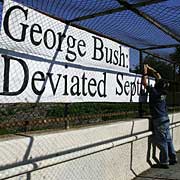
       
MTV Online

War In Iraq Turns L.A.
Into Battleground For Street Artists
10.05.2004 3:16 PM EDT
When Patrick, a 42-year-old self-employed father of two, heard that American
casualties in Iraq had reached 1,000, he knew what he had to do. He was
going to have to make more signs.
For the past two years, the Orange County, California, resident has hidden
himself behind the moniker "Freeway Blogger," scouring the highways of
Southern California, tagging interstate overpasses with simple
black-on-white signs containing messages such as "The War Is A Lie," "Osama
Bin Forgotten" and "Rumsfailed."
Patrick's response to 1,000 dead soldiers was a rush to put up 100 signs in
a single night. He almost made it, but fatigue forced him to stop at 83.
Still, the Freeway Blogger's exhaustion only meant more canvas for other
public protest artists.
The 2004 election has been a boon for political street art around Los
Angeles. Everyone, from graffiti writers and underground poster makers to
design superstars such as Shepard Fairey and internationally respected
artists like Robbie Conal, are taking their message to the streets.
Carol Wells, who has been archiving political public artwork at the Center
for the Study of Political Graphics in Los Angeles since 1989, said there's
been such a flurry of activity, "I can't keep up."
The art explosion has also been noticed by such veterans as "Mear One," a
32-year-old graffiti painter who's been a staple of the Hollywood and East
Los Angeles aerosol set for the better part of two decades. "A lot of pieces
are going up — more than ever before. People are going off in full-color and
posting Kinko's Xerox copies, companies are mirroring graffiti tactics by
printing up stickers with political slogans. ... You can't escape from it."
Los Angeles may be the perfect location for this kind of rebel renaissance.
In its miles of concrete-lined freeways, as well as the highway entrances
and switch-light boxes that dot its automotive-minded landscape, L.A. has
plenty of public surfaces for street artists to showcase their work on. And
with its omnipresent traffic jams, it has a sizeable audience for those
works as well.
Southern California's strong cultural ties to Mexico and that country's
tradition of mural-making has also long been reflected in local graffiti.
Not content to simply tag, graffiti writers have long drawn about "issues
that affect them personally, whether it's the different propositions that
have come up or the three-strikes law," said Mear. "Especially things that
affect their ethnicity, their culture, their rights."
Longtime observers of political street art such as Wells and Conal, who at
60 is one of the godfathers of modern political art in the United States,
say the Bush presidency has energized artists. "That Bush can activate the
street, that he can get skateboard and graffiti kids pissed off enough to
make art, that's amazing," Conal said.
This is equally true of independent firebrands like "Billy Nose," a
48-year-old South Central Los Angeles schoolteacher, who since January has
been night-crawling through Venice and Santa Monica, putting up posters.
Nose, whose paintings can be seen in various Los Angeles galleries, said he
began putting up politically charged drawings on street corners because he
felt the artistic community wasn't answering its ideological call. "There
was a lot of bitching but nobody doing anything. I stopped waiting, went in
the night, just did it and felt born again," he said.
Nose's first broadside, titled "Greed," was a caricature of Mickey Mouse,
who "used to mean love and family, but is now the most perfect icon for
greed I could think of," he explained. As the year has progressed, Nose's
posters have been increasingly critical of the Bush administration's
actions. One titled "Free Speech" was a caricature of FCC chief Michael
Powell, while "Stop It America" presented the image of an Iraqi being
tortured at Abu Ghraib.
Shepard Fairey, too, felt the need to act. The work of the 34-year-old
graffiti artist/graphic designer, best known for his multitude of "Andre the
Giant Has a Posse"/"Obey Giant" stickers and posters, rarely approached
politics until the controversial election of 2000. But it was in March 2003,
on the eve of the war in Iraq, that Fairey's art truly underwent a
full-fledged political awakening.
This past May, Fairey teamed up with Conal and Mear One to create a triptych
of anti-Bush posters under the name "Be the Revolution." Their late May
tagging sessions, organized by the veteran Conal, placed more than 1,500
posters all over Los Angeles, kicking the political-street-art scene into
overdrive.
Expectedly, many of the artists have suffered a backlash for their divisive
art. Both the Freeway Blogger and Billy Nose have received death threats.
And Fairey, a commercially successful artist, said his design business took
a hit once he began mixing his art with his politics. "Four thousand e-mail
subscribers, about 25 percent of my list, unsubscribed immediately," he
said.
Yet despite such obstacles, each artist expressed joy at the ability to
artistically voice their political opinions through civil disobedience. They
also spoke of the rush — what Conal calls the "hee-hee factor" — of running
around at night, being politically subversive.
On his night of 100 signs, the Freeway Blogger's truck was stopped at 3:30
a.m. by two Highway Patrol officers, who saw his cab filled with un-hung
work. "I said, 'Oh, I was just going to put a sign on the back of this
freeway overpass here.' They couldn't help it — they just cracked up. It's
the middle of the night and here's this anti-war protester and two CHP guys.
But I'm not hurting anything, I'm just trying to get a message out, so
whether they agreed or not, they didn't question it and let me go. They were
glad that I wasn't crazy."
—Piotr Orlov
|








